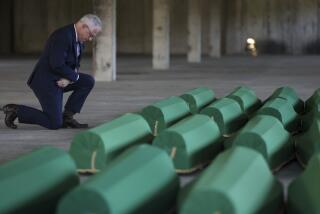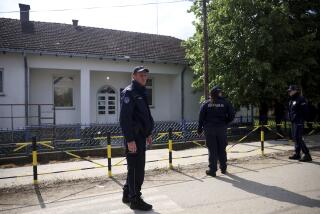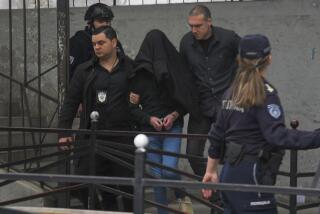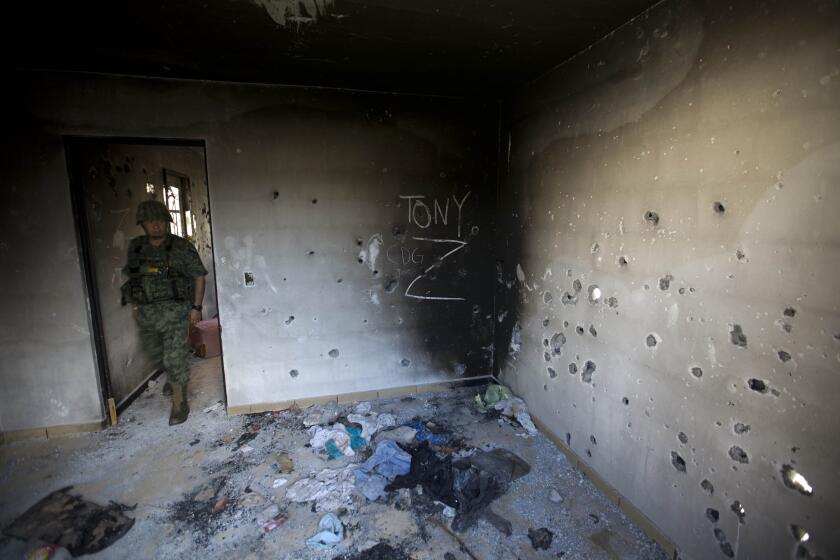Balkan Town Left in Ruins After Tug of War
MRKONJIC GRAD, Bosnia-Herzegovina — Andelka Hilic, old and sick, was left behind in this ruined town to die.
Her fellow Bosnian Serbs--her friends and neighbors--packed up and fled ahead of the advancing Bosnian Croat army three months ago without telling her they were leaving. When the nearly blind, 85-year-old widow went outdoors one day, she found her town deserted.
“I’m too lonely, too weak, too old,” she said, crying and wiping her eyes with a handkerchief. “They should be ashamed.”
Unable to flee, Hilic could only listen as Mrkonjic Grad was demolished--first by warfare among Bosnia’s opposing armies, then by Bosnian Croat soldiers preparing for an American-negotiated peace.
Demonstrating the depth of the hatred in Bosnia and the difficulty peacekeepers face in reconciling the rival factions, the Croatian soldiers who ultimately won Mrkonjic Grad in battle began burning and looting the town after they learned that they would have to give it back to the Serbs under a peace agreement reached in Dayton, Ohio, last month.
By night, the Croatian troops torched hundreds of houses that had survived the fighting. By day, they loaded the entire contents of factories, a hotel and a hospital onto trucks and carted them away before the Dayton accord could take effect.
“They have destroyed Mrkonjic Grad,” said Maj. Phil Macey, commander of a British base on the edge of town. “There is nothing left.”
But when the same Croatian soldiers discovered the old Serbian woman alone in her shell-damaged home, they found compassion amid the chaos.
Despite their hatred of the Serbs, they rescued Hilic, moved her to an undamaged house near their headquarters and began bringing her food and water every day.
“If the soldiers were not here,” she says now, “I would feel unsafe.”
Before the war, Mrkonjic Grad was a thriving town of 27,000 people. More than three-quarters were Bosnian Serbs, with Muslims making up 12% and Croats 8% of the population.
Soon after war erupted in Bosnia-Herzegovina about 3 1/2 years ago, rebel Serbs seized the town, drove out most of the non-Serb residents and destroyed many of their homes. Of those who remained, the Serbs took 400 older Muslim men and women captive and kept them through the war as a local slave labor force, Macey said.
*
Set in a narrow valley on one of the main north-south highways in central Bosnia, Mrkonjic Grad took on vital strategic importance this fall in the waning months of the war as the Muslim-led Bosnian government and neighboring Croatia launched an offensive to force the Serbs from the region.
The battle was hard-fought in Mrkonjic Grad as the Serbs tried to hold on long enough to muster troops from cities to the south.
Ultimately, the Serbs were forced to retreat and cede much of the territory they had seized in central Bosnia to the Croatian forces.
Today, the ruins of Mrkonjic Grad sit amid a 60-mile corridor of destruction, where village after village and town after town have been rendered uninhabitable.
Rusting, disabled tanks sit by the side of the road near gutted houses, restaurants, hotels and factories.
Despite the hard-fought victory in the region, the Bosnian and Croatian governments agreed at Dayton to give much of the area around Mrkonjic Grad back to the Serbs in exchange for land concessions from the Serbs elsewhere in Bosnia.
In their anger, the Bosnian Croat soldiers began looting and burning houses before the Serbs returned, sometimes torching more than a dozen at a time.
Less spontaneous was the removal of goods from the town.
Men appearing more like professional movers than soldiers carefully packed up huge pieces of machinery, furniture, medical equipment and other goods and loaded them onto trucks. On some days, a convoy of 20 trucks would leave Mrkonjic Grad in the direction of Croatia.
The North Atlantic Treaty Organization-led peacekeeping forces, which started arriving in the area in late November, were powerless to stop the looting and destruction because it occurred before the Dayton accord was formally signed by representatives of the three factions, Macey said.
On Dec. 14, the day of the signing in Paris, the looting stopped, although an occasional house in Mrkonjic Grad still goes up in flames.
Soon after their arrival, British troops helped evacuate the group of 400 Muslim slaves who were freed when the Serbs were driven off.
Only recently did the British learn that Andelka Hilic and two other elderly women--including one with a disabled daughter--had been living on their own in different parts of the town. The women did not know of each other’s existence.
Unlike Hilic, Rasema Marsic chose to stay behind. A Muslim, she and her 41-year-old daughter, Zuhra, live in a two-room house across the street from where burning and looting occurred.
“I looked through the window and said, ‘I hope it doesn’t burn to my house,’ ” recalled the tiny, cheerful Marsic, who said she thinks she is about 70 years old. Before her neighbors left, some tried to persuade her to go and others brought her food, firewood and blankets.
“I will stay, whoever comes and whoever leaves,” she said as she boiled cabbage on her wood stove. “I have always been here. What God decides, that is what will be.”
Across town, Hilic’s hope is that she will live long enough to see her neighbors return.
With no one to visit, and unable even to knit because of her failing eyesight, she has been very sad, sleeps poorly and cries a lot.
“I was left on my own without any knowledge the Serbs were gone,” she said, her anger welling up. “My neighbors left without telling me. I hope to God I’m still alive when they come back. When they come back they will get a good scolding.”
More to Read
Sign up for Essential California
The most important California stories and recommendations in your inbox every morning.
You may occasionally receive promotional content from the Los Angeles Times.










